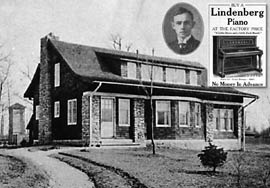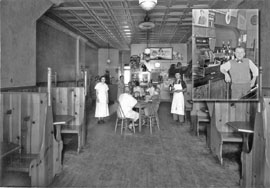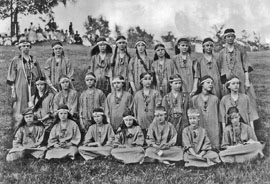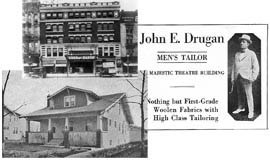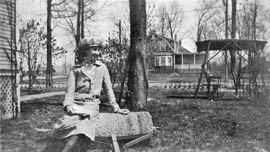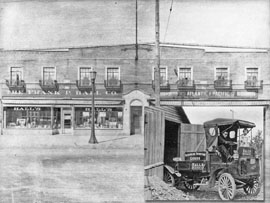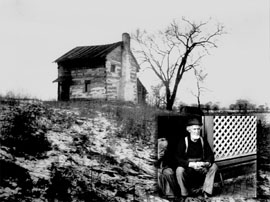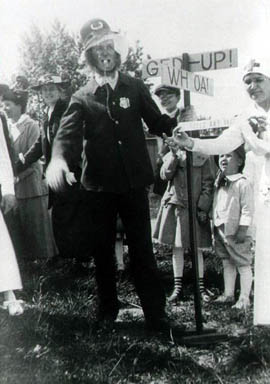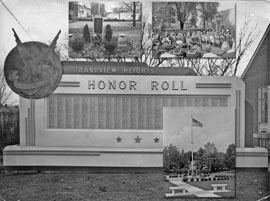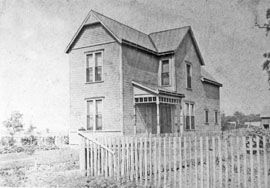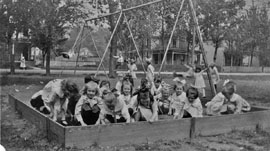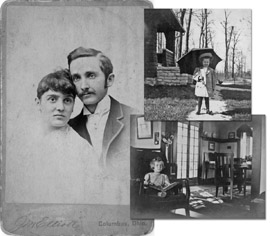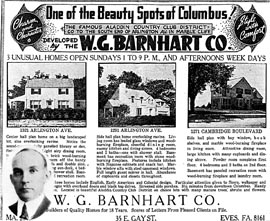| |
|
|
Paul Lindenberg
|
|
In 1905 Paul Lindenberg (oval inset) had noted Columbus architect Frank
Packard design a home which was built at the southeast corner of Cambridge
and First Avenues (1272 Cambridge). It was one of four Lindenberg family
homes in the area. The original home was relatively modest is size but has
had numerous additions over the years, and the exterior was stuccoed. Paul
was the manager and subsequently president of the Lindenberg Piano Company,
which was originally named the Columbus Piano Company. The enterprise took
advantage of post civil war posterity by direct marketing pianos via magazine
and newspaper advertisements, one of which is reproduced here. Paul was
also a golf champion. He repeatedly outplayed most local golfers and set
a course record during the 1912 Ohio State Amateur Competition at the Inverness
Country Club in Toledo, Ohio. |
|
|
Carl Hoster Residence |
|
In 1902 Carl J. Hoster (lower right), a member of the Hoster Family Brewery
dynasty, built his country estate on lots #46 and #47 of the Arlington Place
subdivision, now 1368 Arlington Avenue. He favored this location because
of its close proximity to the Arlington Riding and Golf Club, which was
directly west of his home (Arlington Avenue did not extend south of Third
at the time.) The main house (lower left) was complimented by an equally
impressive combination stable, carriage house, and servant’s quarters
(upper right) east of the main house. By the time the caricature of him
was published in 1911 (upper left inset) Carl was president of the Hoster-Columbus
Associated Breweries Co., a director of Clinton National Bank, the President
of the U.S. Brewers Association, and benefactor of the $10,000 Hoster-Columbus
Stake horse race grand prize bearing his name ($10,000 in 1911 was equivalent
to about $198,000 in 2005). Posterity would also recognize him as the great,
great uncle of President George W. Bush. |
|
|
Knotty Pine Grill |
|
Biase Ciccone and his wife Maria opened their grocery store in a building
on the corner of Westwood and Third Avenue in 1933. The building formerly
housed a Kroger grocery store, then a shoe repair and barber shop. Two years
later, Biase opened a tap room in the west half of the building, leaving
the market to be operated by Maria on the east side. For reasons that are
obvious in this photo, he called it the Knotty Pine. Biase (inset) operated
it until his death in 1958 with help from his son Gildo in his final years,
and it was later purchased by his son-in-law Carl Scartz, who renamed it
Carl's Knotty Pine. This 1937 photo shows waiter Albert Rosetti and waitress
Mary Dello, with Maria standing behind the customers, and her daughter Louise
in the back at the cash register. |
|
|
Delta Gamma Pi |
|
Sororities and fraternities were a part of the social network for Grandview
High School students from 1915 until they were disallowed in Ohio by an
action of the state legislature in 1960. Although they were never sanctioned
by the school, they provided a structure for service, activities, events,
and meetings for students. The oldest boy's organization was the Brotherhood
of the Rook, established in 1915, joined later by the Adonis Club in 1953.
The girls had two sororities, the L.A.L. sorority, started in 1922, and
the Delta Gamma Pi, which started in 1929. This 1932 photo shows girls from
DGP on a "rush" party for new members, which was a 7:30 a.m. bike
ride up and down Riverside Drive. Shown are Kay Field, Betty Booth, Alice
Beaman, Jane Harmount, Ruth Shoemaker, and Dolly Brock. |
|
|
1916 Camp Fire Girls |
|
The Camp Fire Girls organization was founded in 1910, chartered nationally
in 1912, and local affiliate groups started across the nation soon after.
This photo shows the 1916 members of the local Grandview Chapter, the Sciole
(Scioto-Olentangy) branch. The chapter director was Pleasant Barton Higgs,
standing at the top left, who also served as Grandview's village clerk and
water meter reader. Her daughter Pleasant (Alleyne) Higgs is in the second
row at the far left. The girl in the second row, third from the right, is
wearing a swastika necklace. For over 3000 years, until the swastika was
appropriated by Adolf Hitler and became known as a symbol of hatred, it
was a symbol that represented life, power, strength and good luck, and was
worn by the Camp Fire girls, WWI American soldiers, the Boy Scouts, and
many native american tribes. |
|
|
Miss Cherry Blossom
Musical |
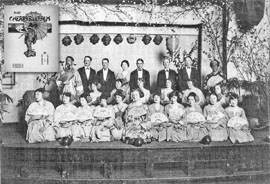 |
High school musicals have been a longstanding tradition in Grandview Heights.
This cast photo is from the February, 1921 production of the musical "Miss
Cherry Blossom", by John W. and May Hewes Dodge (poster, inset upper left).
The Dodge team wrote several musicals popular with high schools in the 20s
and 30s, including "In the Garden of the Shah" and "Rose, Wonderful Rose".
This musical comedy was sponsored by the Booster Association and was directed
by Mrs. H.D. Taylor (back row, 4th from left), music supervisor for the
Grandview Heights City Schools. The play starred Bob Rex (back row, 3rd
from left) and Virginia Baker (front center). The stage was located in the
Harding Building on Fairview Avenue, which served as the high school until
1922 before the current high school building was completed. |
|
|
John E. Drugan |
|
Always dapper and distinguished, the well-dressed John E. Drugan was one
of Columbus's most celebrated tailors. Pictured (right) in this April 1921
advertisement in the Norwester Magazine, he lived with his wife and four
children at 1330 Wyandotte Road. His business was in the Majestic Theatre
Building, which was on South High next to the Neil House until it was razed
in 1950. Mr. Drugan was an avid walker and as late as 1921 never owned an
automobile. An article in the same issue of the Norwester stated that if
you never heard of him then you could not count yourself well acquainted
with the business life of the capital city. Within the past 85 years the
original Drugan home (left) has undergone several renovations including
the addition of a two-car garage to the north side of the house. It is currently
owned by Debbie and Jim Waddell. |
|
|
Mayor Ricketts |
 |
James S. Ricketts was a traveling preacher from Monday Creek Township,
Perry County, Ohio, who established a real estate business in Columbus
in 1889. He helped build the 5th Avenue and King Avenue Methodist Churches
and developed tracts of real estate north of Fifth Avenue. He also
had the dubious honor of being the first mayor of the Village of Marble
Cliff during its very turbulent and formative years of 1904-1905. His
vehement opposition to the sale of alcohol pitted him against saloon owners
along Fifth Avenue and members of the Arlington Country Club. Rickett's
views were not held by the Village Marshall, C. E. Herrel, who took every
opportunity to undermine the mayor’s authority. Press coverage at the
time indicated that when the mayor ordered the arrest of a local saloon
keeper the marshall retaliated by impounding the Mayor's cow and calf
which escaped from their corral. The temperance controversy culminated
in the arrest of the mayor and a near revocation of the Village Charter
in June of 1904. Mayor Ricketts was eventually vindicated. He served almost
two terms then abruptly resigned to become a book salesman in February
of 1905. |
|
|
W. W. Williams Co. |
|
As the new century unfolded, access to the Grandview area from downtown
Columbus was made more convenient by new bridges over the Olentangy and
Scioto Rivers, and businesses and factories grew along the Goodale Blvd.
At 40 years of age, William Wallace Williams (upper left) started one of
these new companies in 1912, and expanded in the early 1920s to be one of
the largest industrial operations in Grandview. His manufacturing enterprise,
W.W. Williams Co. (now located at 835 Goodale) and Columbus Tile and Marble
anchored the industrial operations along this corridor. The photo above
shows workers making rubber conveyor belts at another manufacturing plant,
the Columbus Conveyor Co. that was housed in a building owned by Williams
near Goodale and Northwest Blvd. |
|
|
Frank Butterworth Yard
|
|
This photo (circa 1914) shows an unidentified girl, possibly Dorothy Butterworth,
sitting on a concrete lawn compactor in the back yard of the Frank Butterworth
family home at 1935 West First. This home was built in 1903 and was owned
by his wife Harriet until 1914, after Frank died in 1913 from a fall down
an elevator shaft. The house in the background is at 1905 West First, and
was owned by the McCarty family. P. A. McCarty was Grandview's first high
school principal and served until 1919. |
|
|
Howell Flood Rescue |
|
In March of 1913, a devastating flood destroyed much of Columbus' near
west side and killed nearly 100 people. More would have died were it not
for the efforts of citizens who helped rescue stranded people and animals.
One group of these good samaritans was the Howell family of Broadview Avenue,
who are shown here as they prepare their boats to help in this rescue effort.
A notation on the photograph says "How many people was it we rescued
- 423 1/2 wasn't it? You know we got one M.M.I. cadet." The Howell's
stable and barn shown here were located behind their home at 1082 Broadview,
and were accessible by a pass-through carriage house that was built under
the front porch of the house. |
|
|
Frame/Howell Living Room - 100
Broadview |
|
A common practice in the late 1800s and early 1900s was to make personal
photos into postcards, and they have become very common as historical records
of the time. In March of 1910 Adrienne Frame Howell of 1100 Broadview Ave.
(upper right) sent the picture postcard (left) of her new "living room"
to her brother Augustus Frame of Athens, Ohio. Adrienne was obviously a
devotee of the Arts and Crafts style of the period. She used the new term
"living room" in her message on the postcard, and she sparsely furnished
the room with mission style, craftsman oak furniture like the library table
and rocker in the foreground. Her dining room (lower right) included simple
oak furniture, an authentic Tiffany hanging lamp, and built-in cabinets
typical of the period and style. An avid china painter, Adrienne maintained
a studio on the second floor of her home for that creative purpose. |
|
|
Northwest Boulevard Company Ads |
|
In March, we featured a photograph of a house that we had been unable
to locate in Grandview (upper right) that was taken from an early advertisement
for the Northwest Boulevard Company, the developers of the east side of
Grandview Heights. A ThisWeek Grandview reader emailed us that she thought
her house at 906 Copeland (middle right) was the featured house. By looking
at current photos of two other houses (lower right) located on Timberman,
viewed at the approximate angle shown in the background of the original
1920 photo, we can confirm that this is in fact the featured house. Another
ad from the same developer featured a house on Mulford Road (upper left).
A local resident wrote to us that her home at 1286 Mulford (lower left)
was likely the house. By checking architectural elements, such as the unique
window in the side of the dormer and chimney size and location, we are confident
that this is the featured house. |
|
|
Hall's Hardware |
|
Frank P. Hall Hardware was a famous Columbus company that operated locally
from 1907 until 1972. Hall's main store was located at 115 S. High Street,
and at its height the organization had a total of thirteen stores operating
in the area. Hall's Hardware was an original tenant of the Grandview Bank
Block in 1927, shown in the photo. The license plate on the delivery truck
in the inset photo on the right is stamped 1912. The truck was manufactured
by the Auglaize Motor Company of New Bremen, Ohio and is driven by an unidentified
employee (note the hand crank starter below the radiator of the truck).
Frank P. Hall was the grandson of Timothy J. Price, who platted the first
subdivision of Marble Cliff, Arlington Place. The Hall family home at 1631
Roxbury Road was eventually razed to build the "French Quarter" condominiums. |
|
|
Daniel Thomas Cabin |
|
Daniel Thomas (lower right) arrived in 1844 to the area that would become
Grandview Heights, and discovered this cabin. Located between the Olentangy
River and what is now Northwest Boulevard, the cabin was covered in climbing
vines with mud filler for the crudely hewn logs, according to a 1908 article
in the Ohio State Journal. Thomas lived in the cabin for fifteen years while
farming the area between Goodale Boulevard and 3rd Avenue, vacating it after
he built a large farmhouse and barn nearby. It remained empty for several
decades until his grandson, James O. Thomas moved into it in 1890. James
Thomas, the father of Caroline Thomas Harnsberger who was recently honored
with admission to the GHHS Alumni Hall of Fame, lived there until he moved
into his new house on the hill near Goodale on the west side of Northwest
Blvd. He and his family farmed there until the entire farm was sold in 1916
to the Northwest Boulevard Company for subdivision into lots for homes.
The original Thomas home at 789 Northwest Boulevard was razed approximately
twelve years ago to build The Grand View of Columbus Condominiums. |
|
|
Hanger collection - RLS School
|
|
From the beginning of the planning for the Robert Louis Stevenson Elementary
School in 1923, to its opening in 1926, and until the end of the term in
1938, the students and staff dutifully maintained a scrapbook of each year's
major events. The students wrote most of the historical text including captions
for the photographs. The following description was typed seventy-three years
ago by then 6th grader Oakley Cline for the photo above: “When the Grandview
P.T.A. needed money for welfare work in the spring of 1933, they collected
coat hangers and sold them to the dry cleaners. There were seven thousand
collected. The dry cleaners paid four dollars per thousand for them.” At
the time of Mr. Cline's writing, the country was in the midst of the Great
Depression. The $28 collected by the students would be equivalent to $380
in today's dollars. The girls pictured with the mound of hangers on the
steps of the school were not identified. The contents of the scrapbook can
be seen on our website at http://www.ghmchs.org/tour-pages/stevenson.html |
|
|
Oliver Clyde Weist |
|
Between the years 1915 and 1925, the event of the year was the Grandview
Heights, Marble Cliff, and Upper Arlington Field Day Celebration. This annual
holiday activity was held in early summer and featured a parade, food, a
baseball game between GH and UA, children's games, etc. It was the brainchild
of the dynamic and progressive pastor of First Community Church, Oliver
Clyde Weist, shown here dressed as a "Keystone Cop" The woman dressed in
a Red Cross uniform was not in costume but was an actual member of the local
chapter charged with making bandages during WW I. She is holding a sign
that says "Field Day 1917". Mr. Weist was FCC pastor for 16 years
and has been credited with changing the denomination of the church to a
community church, establishing a vested choir, and recruiting 1,936 new
members to the congregation. He was often quoted as saying that he switched
his first two given names, Oliver and Clyde, so that his initials would
not spell C.O.W. |
|
|
Grandview Honor Roll |
|
Grandview Heights Memorial Park, now located at the intersection of Second
and Oxley Avenues (inset bottom) was originally at the southwest corner
of Oakland and First Avenues, adjacent to the Grandview Library. It evolved
from the WWII era practice of erecting "Honor Rolls" to identify
those serving in the armed services. Grandview's Honor Roll (background)
was dedicated on March 26, 1944. It listed the names of 550 active duty
service men and women from Grandview Heights and Marble Cliff. After the
war a Memorial Park (top left) containing a single bronze plaque with the
names of the service men who died, together with marble benches and urns,
replaced the Honor Roll on the same site. This park was dedicated (top right)
in a ceremony on May 23, 1948. The addition of the east wing of the library
prompted the need to move the plaques and benches of the Memorial Park to
its present location, and it was rededicated on May 27, 1970. A second plaque
was added containing names of the dead from the Korean and Vietnam conflicts.
From the beginning a driving force behind these tributes to local service
men and women has been the local chapter of Blue Star Mothers. |
|
|
Football Program Cover |
|
This Fred Fixler painting was the cover of the football program for the
1960 game between Grandview and Hilliard. The Bobcats lost the contest 20-14
that night, but the team played strong games later in the year. This cover
portrait is part of a collection of football program covers donated to the
Historical Society by Al Rosetti, who was one of the team captains on the
Bobcat squad the next year. The speaker at the football banquet this year
was Tad Weed, who graduated from Grandview in 1951 and played for the Ohio
State Buckeyes, kicking for Coach Woody Hayes on the 1954 Buckeye national
championship team. He later played for the NFL Rams and Steelers. Weed passed
away last week. |
|
|
Elizabeth Ohnsman residence |
|
Excerpts from the GHMCHS publication Sheltering a Heritage indicate
that this house at 1226 Broadview was built for Elizabeth Ohnsman in 1892.
Her husband John (a local farmer), died a year earlier, leaving Elizabeth
and her six children to fend for themselves. Records indicate that the house
was the only house on Broadview for nearly a decade before others were built
south of First. The date of the photo this is unknown but it shows an addition
that was reportedly added to the back of the original structure. Elizabeth’s
youngest child John Levi built his home and office just to the south on
the northeast corner of West First and Broadview, now the site of National
City Bank. John was a prominent cement contractor. The 1930 edition of History
of Franklin County states that practically all the sidewalks in Grandview
and Upper Arlington were laid by his firm. |
|
|
Edison students - 1918 |
|
Dressed in bows and dresses, these second grade girls are enjoying recess
in the sandbox on the playground of the Grandview Elementary School. The
photograph is dated 1918 and shows homes on Oakland Avenue near First Avenue
in the background. The Grandview Elementary School was built in 1911 at
a cost of $50,000. It was built on Fairview across from the Harding School.
It later became the Grandview Junior High School (currently the Grandview
Middle School) when a west wing, facing Oakland Avenue was added in 1930
(Edison Elementary School). The homes (left to right) are identified as
belonging to the Jesters, Whittridges, and Wagners. Sally Tremaine, Elizabeth
Brennamon, Jeanette Gutches, and Mary Glass are noted as being among their
classmates in the sandbox but have not been identified. If any of the readers
can identify any of the children please contact the GHMCHS. |
|
|
First Ave. Bridge Club
|
|
Eleven local couples comprising a weekly bridge club are shown here on
the front steps of the home (inset) of Christian and Eva Jaeger at 1806
West First in Grandview. Mr Jaeger (2nd row from front, 4th from left) was
a prominent Columbus insurance man, with offices on Gay Street downtown.
Mrs. Jaeger (2nd row, far left) was a direct descendent of Revolutionary
War hero John Davis, who was with George Washington at the crossing of the
Delaware and who is reported to have carried Marquis de Lafayette to safety
after he was wounded in the Battle of Brandywine. Davis' wife was Ann Simpson,
who in her own right was a war hero. At 15 years of age she was a spy for
George Washington, carrying messages in bags of meal between commanding
officers of the American Army. The Davis' moved to Dublin, Ohio after the
war. The Columbus chapter of DAR was named after Mrs. Davis. |
|
|
John and Margaret Hussey |
|
John Edwards Hussey and his wife Margaret (left) built their home at 1367
Wyandotte Road, in the Gladdington Heights Subdivision, during 1905-1906.
It was an Arts and Crafts home as apparent in the period interior photograph
at the bottom right. Their daughter Eleanor (b1902) is seated in the photo
and is holding the umbrella in the photo looking north across their front
porch. John was an 1885 graduate and subsequently a faculty member of the
Columbus College of Art and Design, and was director and curator of what
eventually became the Columbus Museum of Art. He was a founding member of
the Pen and Pencil Club and a charter member of the Columbus Art League
(now the Ohio Art League). He was brought out of retirement in 1920 by the
Dean of the College of Agriculture at The Ohio State University and worked
an additional 26 years as an "assistant in horticulture". He designed gardens
and was charged with beautifying the campus. He retired again in 1946 as
the university’s oldest staff member and died at the age of 105 in November,
1969. |
|
| |
Charles Butterworth's Little
Four |
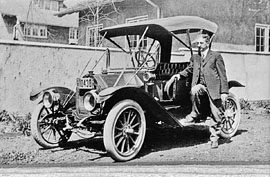 |
Grandview resident Charles Butterworth of Lincoln Road stands with his
foot on the running board of his 1913 Chevrolet Little Four roadster. The
two passenger car was built in Flint, Michigan by the Little Motor Company
and sold ("fully equipped") for $690. Its 20 horsepower four cylinder
engine with a specially designed carburetor provided sufficient power for
this speedster. Its leather seats and mohair convertible top with removable
curtains made it a desirable second car for the wealthy. The advertisement
for the car stated "with its full nickled mountings, there is no brass
to polish!" |
|
| |
Timothy J. Price |
|
Timothy J. Price was born in Wales in 1810 and immigrated to the U.S.
in 1829. He was listed as a carpenter in the 1843 Columbus directory and
worked on the interior of the Statehouse. He also owned the limestone quarry
just north of the Village of Marble Cliff. His quarry provided most of the
limestone used for the road beds of High Street and other major Columbus
thoroughfares and a block of his limestone is in the Washington Monument.
He figured most prominently in local history by platting "Arlington
Place" in 1889. Arlington Place was the first development in the area
and comprised the northern border of present day Marble Cliff. Three Price
family estates lined the hill on the west side of Roxbury between Fifth
and Cardington Avenues. T.J. Price died in 1892. His family home survived
subsequent development and demolition in the area and was moved in 1914
to its present location at the south east corner of Arlington and Cardington
Avenues. |
|
| |
Construction of Grandview High
School |
|
Perched high on the scaffolding, workmen are putting the finishing touches
on the chimney of the new Grandview Heights High School prior to its opening
on September 17, 1923. The school contained 22 rooms and was designed to
accommodate 600 students. It cost $290,000 and was built by the L.L. LeVeque
Company. Innovative for the time, when the merits of physical education
were just being recognized, the new school contained a combination gymnasium
and auditorium with removable seats. This view from the back of the building,
looking north towards Third Avenue, has changed significantly by early additions
to both wings on the left and right, and the major additions of the current
gymnasium in 1957 and the industrial arts wing in 1971. The chimney has
also been shortened. |
|
| |
Kel W. Osborne |
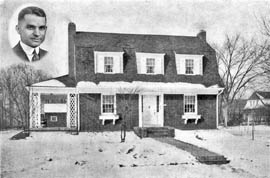 |
Kel Warren Osborne (inset) and his family home at what is now 1115 Elmwood
were featured in the Who’s Who column in the March, 1922 Norwester magazine.
Except for enclosing the porch on the left side, the home has changed little
since Kel resided there with his wife, Ivah and daughters Mary and Helen.
Mr. Osborne was a successful plumber and owned and operated the North Side
Plumbing Company at 745 North High Street. Active in the community, Kel
was a Mason, skipper of the Buckeye Yacht Club, and Elmwood Street Captain
for the Annual Field Day Parades. He must have performed his parade duties
in an exemplary fashion, for his descendants recently donated to the GHMCHS
a very large, engraved sterling silver loving cup that he received from
the 1923 Field Day Committee. His daughter Barbara also won the baby contest
that year. Her engraved first-place sterling silver spoon is also now in
our collection. |
|
| |
W. G. Barnhart |
|
Wilber G. "Barney" Barnhart (shown in a 1920 photo) began building block
houses in his native Madison County around 1879. For brief periods he taught
school and was also a traveling salesman for the Duxback Clothing Company
of Utica, New York. By 1922 he returned to building and organized the W.G.
Barnhart Company of which he was president and general manager. One was
his first projects was construction of the Masonic Temple on the northwest
corner of First and Grandview Avenues. However his greatest impact was undoubtedly
the development of the tract of land that was the former Aladdin Country
Club. His Aladdin Country Club Addition was comprised of 20 lots. This circa
1940 advertisement shows three colonial homes on Arlington and Cambridge
Avenues, all priced in the $14,000 range. |
|
|
|
|
|
|




